(eTextbookPDF)forDiversityinOrganizations3rd EditionbyMyrtleP.Bell

https://ebookmass.com/product/etextbook-pdf-for-diversityin-organizations-3rd-edition-by-myrtle-p-bell/

Instant digital products (PDF, ePub, MOBI) ready for you
Download now and discover formats that fit your needs...
(eTextbook PDF) for Social Change 3rd Edition by Jay Weinstein
https://ebookmass.com/product/etextbook-pdf-for-social-change-3rdedition-by-jay-weinstein/
ebookmass.com
(eTextbook PDF) for Investigating Oceanography 3rd Edition by Keith
Sverdrup
https://ebookmass.com/product/etextbook-pdf-for-investigatingoceanography-3rd-edition-by-keith-sverdrup/
ebookmass.com
(eTextbook PDF) for Invertebrates 3rd Edition by Richard C. Brusca
https://ebookmass.com/product/etextbook-pdf-for-invertebrates-3rdedition-by-richard-c-brusca/
ebookmass.com
The Body in the Dumb River: A Yorkshire Mystery George Bellairs
https://ebookmass.com/product/the-body-in-the-dumb-river-a-yorkshiremystery-george-bellairs/
ebookmass.com




Reconsidering Race: Social Science Perspectives on Racial Categories in the Age of Genomics Kazuko Suzuki
https://ebookmass.com/product/reconsidering-race-social-scienceperspectives-on-racial-categories-in-the-age-of-genomics-kazukosuzuki/
ebookmass.com
Reservoir Simulations Shuyu Sun
https://ebookmass.com/product/reservoir-simulations-shuyu-sun/
ebookmass.com
Goodman and Gilman’s The Pharmacological Basis of Therapeutics, 13th Edition (Goodman and Gilman’S the Pharmacological Basis of Therapeutics) 13th Edition, (Ebook PDF)
https://ebookmass.com/product/goodman-and-gilmans-the-pharmacologicalbasis-of-therapeutics-13th-edition-goodman-and-gilmans-thepharmacological-basis-of-therapeutics-13th-edition-ebook-pdf/ ebookmass.com
New Zealand Landscape: Behind the Scene Williams



https://ebookmass.com/product/new-zealand-landscape-behind-the-scenewilliams/
ebookmass.com
1920s Fashion Sourcebook (Fashion Sourcebooks) Fiell

https://ebookmass.com/product/1920s-fashion-sourcebook-fashionsourcebooks-fiell/
ebookmass.com

https://ebookmass.com/product/peasants-making-history-living-in-anenglish-region-1200-1540-christopher-dyer/
ebookmass.com


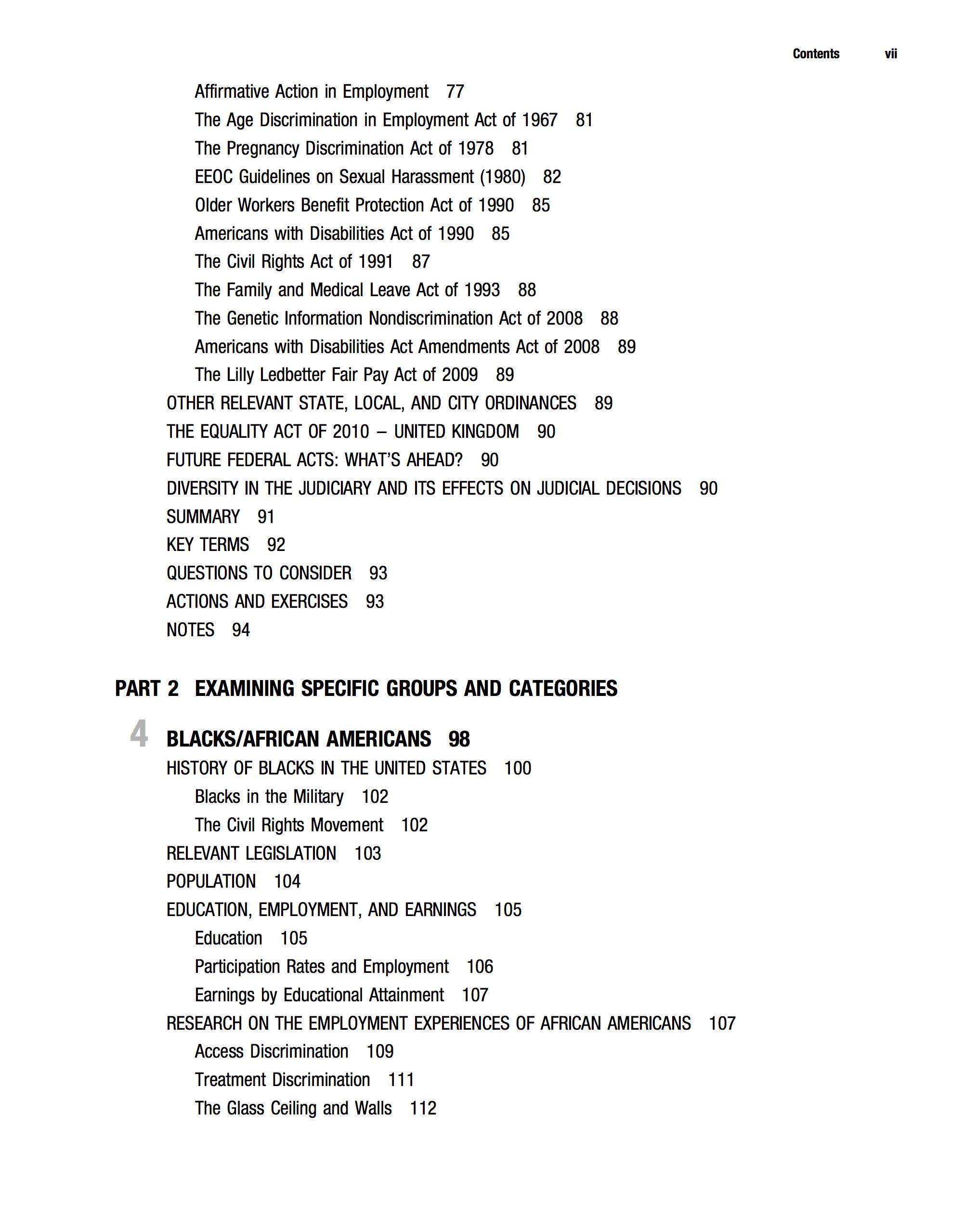
Affirmative Action in Employment 77
The Age Discrimination in Employment Act of 1967 81
The Pregnancy Discrimination Act of 1978 81
EEOC Guidelines on Sexual Harassment (1980) 82
Older Workers Benefit Protection Act of 1990 85
Americans with Disabilities Act of 1990 85
The Civil Rights Act of 1991 87
The Family and Medical Leave Act of 1993 88
The Genetic Information Nondiscrimination Act of 2008 88
Americans with Disabilities Act Amendments Act of 2008 89
The Lilly Ledbetter Fair Pay Act of 2009 89
OTHER RELEVANT STATE, LOCAL, AND CITY ORDINANCES 89
THE EQUALITY ACT OF 2010 - UNITED KINGDOM 90
FUTURE FEDERAL ACTS: WHAT'S AHEAD? 90
DIVERSITY IN THE JUDICIARY AND ITS EFFECTS ON JUDICIAL DECISIONS 90
SUMMARY 91
KEY TERMS 92
QUESTIONS TO CONSIDER 93
ACTIONS AND EXERCISES 93
NOTES 94
PART 2 EXAMINING SPECIFIC GROUPS AND CATEGORIES
4 BLACKS/AFRICAN AMERICANS 98
HISTORY OF BLACKS IN THE UNITED STATES 100
Blacks in the Military 102
The Civil Rights Movement 102
RELEVANT LEGISLATION 103 POPULATION 104
EDUCATION, EMPLOYMENT, AND EARNINGS 105 Education 105
Participation Rates and Employment 106
Earnings by Educational Attainment 107
RESEARCH ON THE EMPLOYMENT EXPERIENCES OF AFRICAN AMERICANS 107
Access Discrimination 109
Treatment Discrimination 111
The Glass Ceiling and Walls 112
Negative Health Effects of Discrimination 113
Immigrant Blacks and Their Descendants and Native-born Blacks Similarities and Differences 114
African American Women at Work 116
Discrimination against Customers: Consumer Racial Profiling 117
RECOMMENDATIONS 118
Recommendations for Blacks 119
Recommendations for Organizational Change 120
Consumer/Customer Service Recommendations 122
SUMMARY 122
KEY TERMS 123
QUESTIONS TO CONSIDER 123
ACTIONS AND EXERCISES 124
NOTES 125
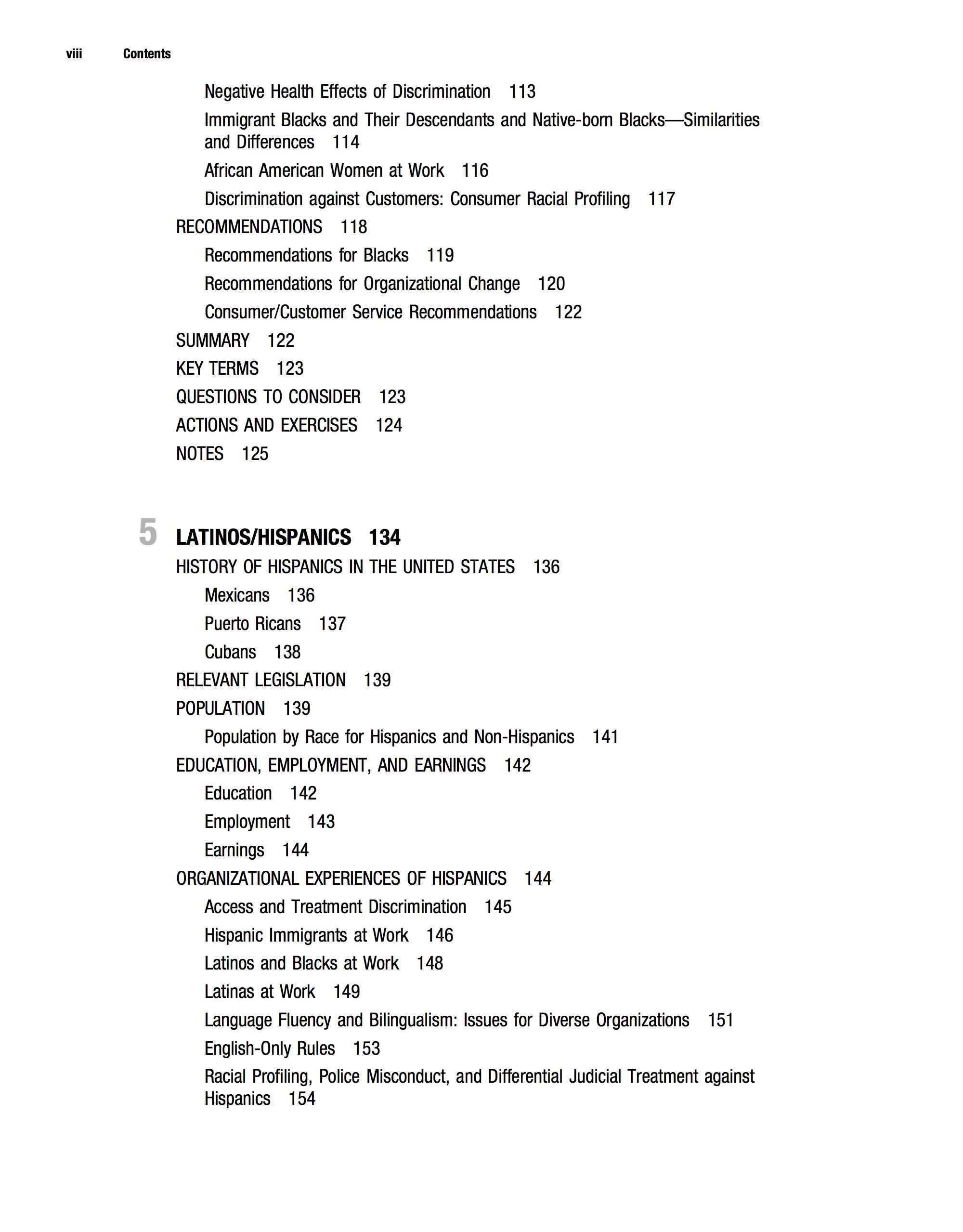
5
LATINOS/HISPANICS 134
HISTORY OF HISPANICS IN THE UNITED STATES 136
Mexicans 136
Puerto Ricans 137
Cubans 138
RELEVANT LEGISLATION 139
POPULATION 139
Population by Race for Hispanics and Non-Hispanics 141
EDUCATION, EMPLOYMENT, AND EARNINGS 142
Education 142
Employment 143
Earnings 144
ORGANIZATIONAL EXPERIENCES OF HISPANICS 144
Access and Treatment Discrimination 145
Hispanic Immigrants at Work 146
Latinos and Blacks at Work 148
Latinas at Work 149
Language Fluency and Bilingualism: Issues for Diverse Organizations 151
English-Only Rules 153
Racial Profiling, Police Misconduct, and Differential Judicial Treatment against Hispanics 154
LATINOS AS CUSTOMERS 155
The Hispanic Market and Buying Power 155
Consumer Racial Profiling against Hispanics 157
RECOMMENDATIONS FOR INDIVIDUALS 157
RECOMMENDATIONS FOR ORGANIZATIONS 158
SUMMARY 159
KEY TERMS 159
QUESTIONS TO CONSIDER 160
ACTIONS AND EXERCISES 160
NOTES 161
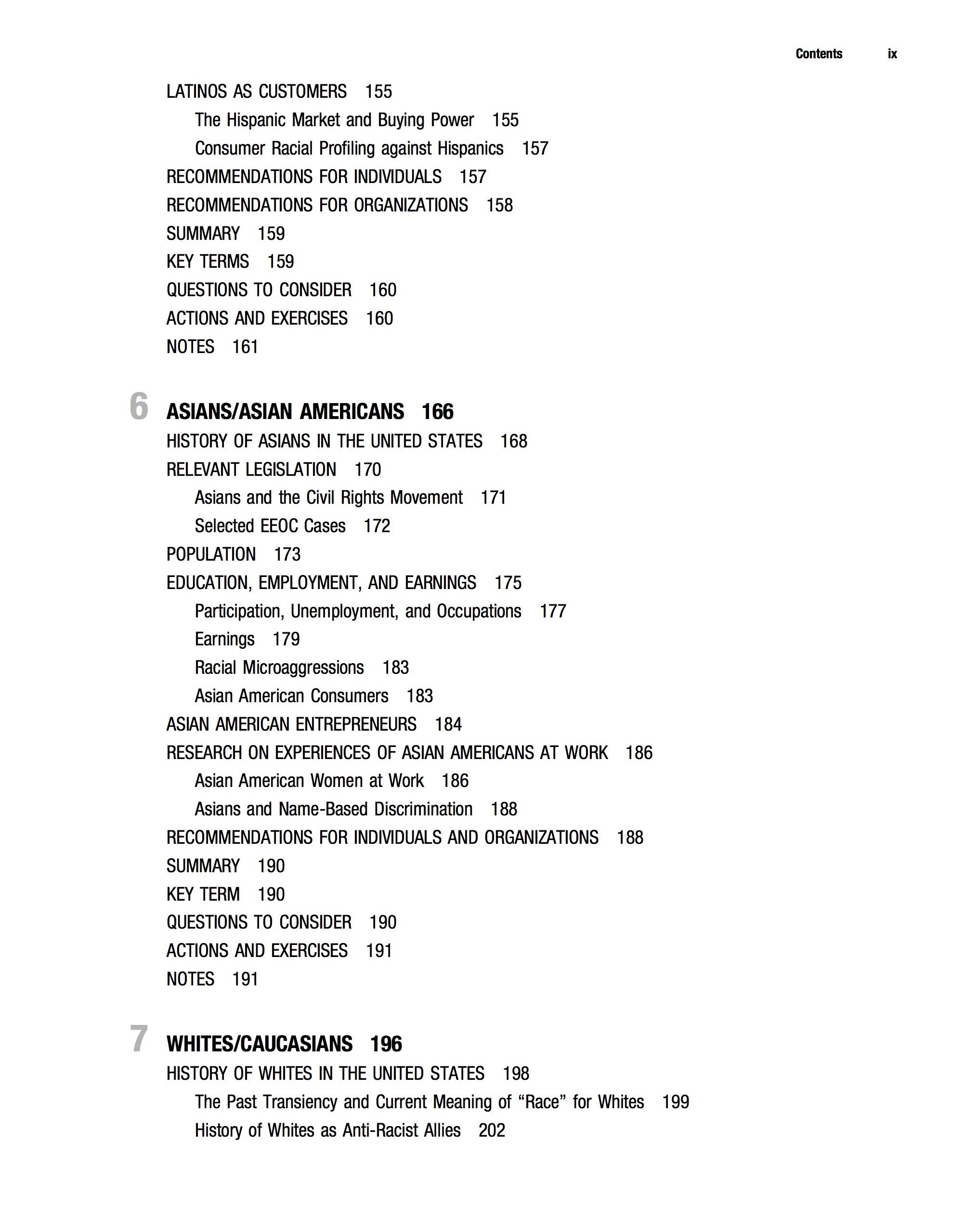
6 ASIANS/ASIAN AMERICANS 166
HISTORY OF ASIANS IN THE UNITED STATES 168
RELEVANT LEGISLATION 170
Asians and the Civil Rights Movement 171
Selected EEOC Cases 172
POPULATION 173
EDUCATION, EMPLOYMENT, AND EARNINGS 175
Participation, Unemployment, and Occupations 177
Earnings 179
Racial Microaggressions 183
Asian American Consumers 183
ASIAN AMERICAN ENTREPRENEURS 184
RESEARCH ON EXPERIENCES OF ASIAN AMERICANS AT WORK 186
Asian American Women at Work 186
Asians and Name-Based Discrimination 188
RECOMMENDATIONS FOR INDIVIDUALS AND ORGANIZATIONS 188
SUMMARY 190
KEY TERM 190
QUESTIONS TO CONSIDER 190
ACTIONS AND EXERCISES 191
NOTES 191
7 WHITES/CAUCASIANS 196
HISTORY OF WHITES IN THE UNITED STATES 198
The Past Transiency and Current Meaning of "Race" for Whites 199
History of Whites as Anti-Racist Allies 202
8

RELEVANT LEGISLATION 204
Race Discrimination against Whites 206
Discrimination against Whites in Favor of Hispanics 207
Termination of Whites for Refusing to Comply with Discrimination against Minorities 207
Associational Discrimination 208
POPULATION 209
EDUCATION, EARNINGS, AND EMPLOYMENT 209
RESEARCH ON WHITES AND DIVERSITY 210
Similarities and Differences in the Experiences of White Women and Men 211
White Ethnic Identity 212
Perceptions of "Quotas " and "Reverse Discrimination " 213
Effects of Increasing Diversity on Dominant Group Members 215
DIVERSITY AND SOCIO-ECONOMIC STATUS FOR WHITES 215
RECOMMENDATIONS FOR INDIVIDUALS 217
RECOMMENDATIONS FOR ORGANIZATIONS 219
SUMMARY 219
KEY TERMS 220
QUESTIONS TO CONSIDER 220
ACTIONS AND EXERCISES 221
NOTES 221
NATIVE AMERICANS AND MULTI-RACIAL GROUP MEMBERS 226
HISTORY OF AMERICAN INDIANS IN NORTH AMERICA 228
POPULATION 230
EDUCATION, EMPLOYMENT, AND EARNINGS 232
RELEVANT LEGISLATION 233
RESEARCH ON AMERICAN INDIANS AT WORK 235
AMERICAN INDIAN AND ALASKAN NATIVE WOMEN 235
MULTl-RACIAL GROUP MEMBERS 236
Introduction and History 237
Blacks and Racial Determination 237
POPULATION 238
RELEVANT LEGISLATION 239
AMERASIANS 240
RECOMMENDATIONS FOR INDIVIDUALS AND ORGANIZATIONS 240
Native Americans and Alaska Natives 240
Multi-Racial Group Members 241
SUMMARY 241
KEY TERMS 242
QUESTIONS TO CONSIDER 242
ACTIONS AND EXERCISES 243
NOTES 243

SEX AND GENDER 248
RELEVANT LEGISLATION 250
POPULATION 251
EDUCATION 251
PARTICIPATION AND EARNINGS
Participation Rates 253
Sex Segregation 253
Income 255
GEN DER ROLE SOCIALIZATION
SEX DISCRIMINATION 261
SEXUAL HARASSMENT 265 252 256
Sexual Harassment of Women 266
Sexual Harassment of Men 267
THE GLASS CEILING AND OTHER GLASS BOUNDARIES 268
SEX , RACE , AND ETHNICllY 271
White Women and Women of Color 271
UNIQUE GEN DER ISSUES 272
Gender and Poverty 272
Negotiating Pay 273
RECOMMENDATIONS FOR INDIVIDUALS AND ORGANIZATIONS 273
Curbing Sexual Harassment 274
Breaking the Glass Boundaries 275
SUMMARY 276
KEY TERMS 276
QUESTIONS TO CONSIDER 277
QUESTIONS TO CONSIDER-FEDEX CASE 277
ACTIONS AND EXERCISES 277
NOTES 278
10 WORK AND FAMILY 284
HISTORY OF WORK AND FAMILY 286
RELEVANT LEGISLATION 286
Equal Pay Act and Title VII 287
Pregnancy Discrimination Act of 1978 288
The Family and Medical Leave Act of 1993 289
Lilly Ledbetter Fair Pay Act of 2009 290
POPULATION, PARTICIPATION, AND EDUCATION 290
EARNINGS 292
Part-time Work and Earnings 293
FLEXIBLE SCHEDULES 294
Unpredictability, Rigidity, and Instability of Scheduling 295
Flexible Schedules for Singles 296
UNPAID AND PAID LEAVES 296
Career Outcomes for Employees who Take Leaves of Absence 297
SAME-SEX COUPLES IN FAMILY RELATIONSHIPS 297
MEN, WORK, AND FAMILY 298
BEYOND THE FAMILY: SOCIETY, ORGANIZATIONS, AND FAMILY ISSUES 299
FAMILY POLICIES IN SELECTED COUNTRIES 300
ELDER CARE 302
PARENTING AGAIN: GRANDPARENTS CARING FOR GRANDCHILDREN 302
RECOMMENDATIONS FOR INDIVIDUALS 303
RECOMMENDATIONS FOR ORGANIZATIONS 304
SUMMARY 304
KEY TERMS 305
QUESTIONS TO CONSIDER 305
ACTIONS AND EXERCISES 306
NOTES 306
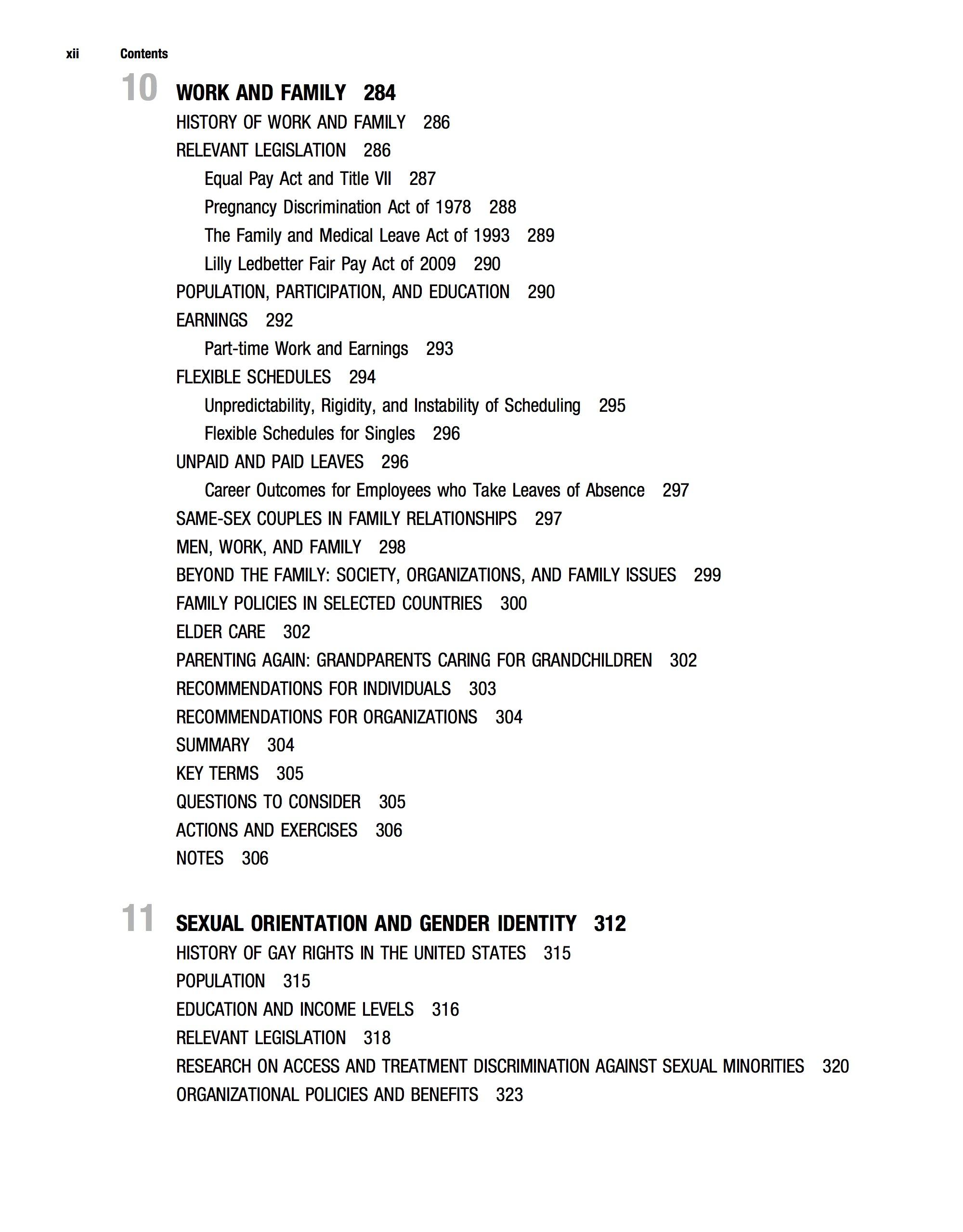
11 SEXUAL ORIENTATION AND GENDER IDENTITY 312
HISTORY OF GAY RIGHTS IN THE UNITED STATES 315
POPULATION 315
EDUCATION AND INCOME LEVELS 316
RELEVANT LEGISLATION 318
RESEARCH ON ACCESS AND TREATMENT DISCRIMINATION AGAINST SEXUAL MINORITIES 320
ORGANIZATIONAL POLICIES AND BENEFITS 323
HIV/AIDS AT WORK: UNFOUNDED FEARS 325
DETERMINANTS OF ATTITUDES TOWARD GAYS AND LESBIANS 326
CODES OF SILENCE, OR OUT AT WORK? 326
RECOMMENDATIONS FOR INDIVIDUALS 329
RECOMMENDATIONS FOR ORGANIZATIONS 330
SUMMARY 331
KEY TERMS 331
QUESTIONS TO CONSIDER 332
ACTIONS AND EXERCISES 332
NOTES 333
12
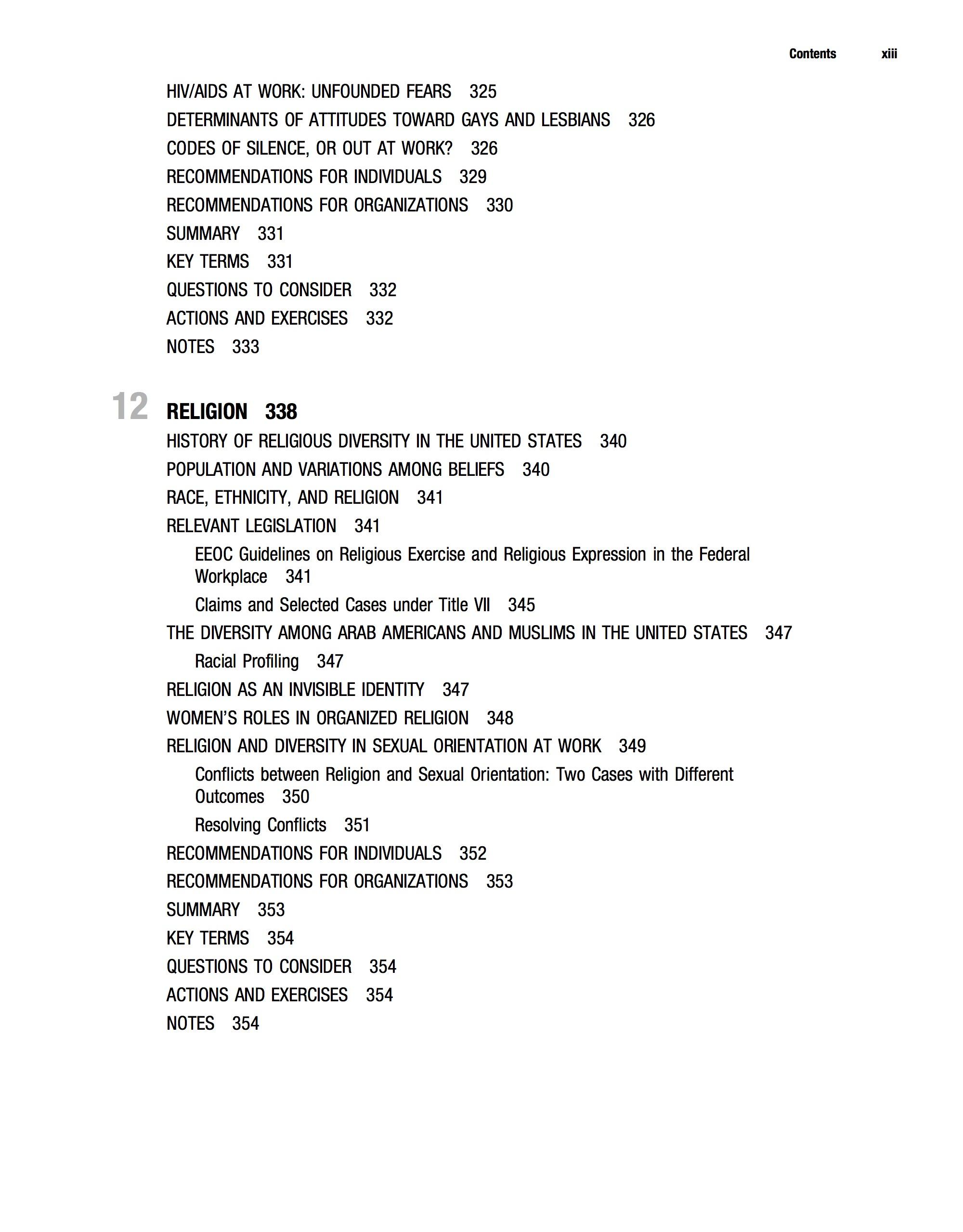
RELIGION 338
HISTORY OF RELIGIOUS DIVERSITY IN THE UNITED STATES 340
POPULATION AND VARIATIONS AMONG BELIEFS 340
RACE, ETHNICITY, AND RELIGION 341
RELEVANT LEGISLATION 341
EEOC Guidelines on Religious Exercise and Religious Expression in the Federal Workplace 341
Claims and Selected Cases under Title VII 345
THE DIVERSITY AMONG ARAB AMERICANS AND MUSLIMS IN THE UNITED STATES 347
Racial Profiling 347
RELIGION AS AN INVISIBLE IDENTITY 347
WOMEN'S ROLES IN ORGANIZED RELIGION 348
RELIGION AND DIVERSITY IN SEXUAL ORIENTATION AT WORK 349
Conflicts between Religion and Sexual Orientation: Two Cases with Different Outcomes 350
Resolving Conflicts 351
RECOMMENDATIONS FOR INDIVIDUALS 352
RECOMMENDATIONS FOR ORGANIZATIONS 353
SUMMARY 353
KEY TERMS 354
QUESTIONS TO CONSIDER 354
ACTIONS AND EXERCISES 354
NOTES 354
13 AGE 358
HISTORICAL BACKGROUND 360
RELEVANT LEGISLATION FOR OLDER WORKERS 361
Selected EEOC Cases Involving Older Age Discrimination Claims 363
LEGAL PROTECTIONS FOR YOUNGER WORKERS 365
POPULATION , PARTICIPATION RATES , AND EMPLOYMENT 365
An Intergenerational Workforce 367
EDUCATION 368
RESEARCH ON EMPLOYMENT EXPERIENCES OF OLDER WORKERS 369
Age, Accidents , and Injuries at Work 370
Training and Development 370
Bridge Employment and Layoffs 371
Older Women at Work 373
RESEARCH ON EMPLOYMENT EXPERIENCES OF YOUNGER WORKERS 375
Sexual Harassment of Teen Workers and the EEOC ' s Youth@Work Initiative 375
Long-term Consequences of Harassment of Young Workers 377
RECOMMENDATIONS FOR INDIVIDUALS 377
RECOMMENDATIONS FOR ORGANIZATIONS 379
SUMMARY 380
KEY TERMS 380
QUESTIONS TO CONSIDER 380
ACTIONS AND EXERCISES 381
NOTES 381
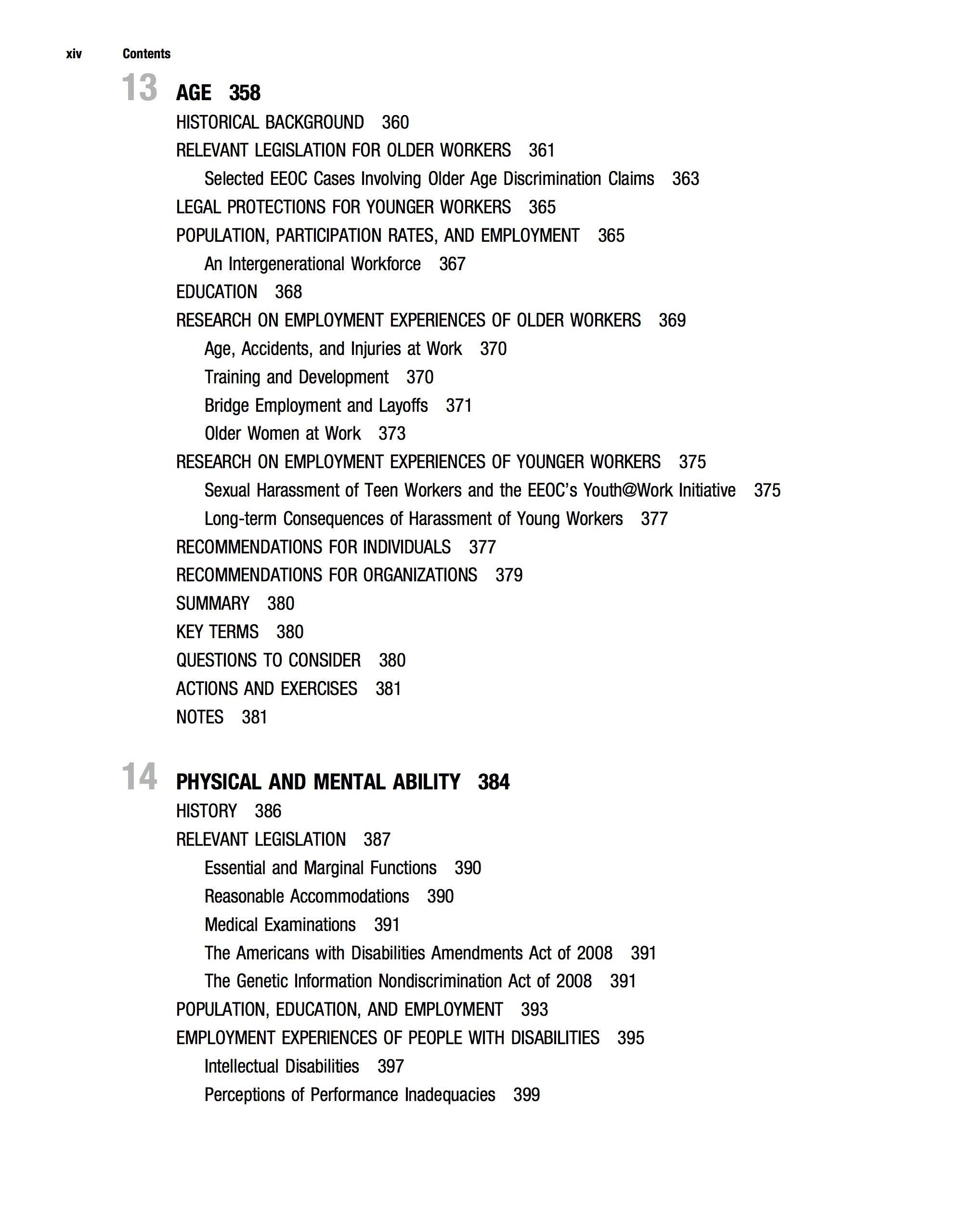
14 PHYSICAL AND MENTAL ABILITY 384
HISTORY 386
RELEVANT LEGISLATION 387
Essential and Marginal Functions 390
Reasonable Accommodations 390
Medical Examinations 391
The Americans with Disabilities Amendments Act of 2008 391
The Genetic Information Nondiscrimination Act of 2008 391
POPULATION , EDUCATION , AND EMPLOYMENT 393
EMPLOYMENT EXPERIENCES OF PEOPLE WITH DISABILITIES 395
Intellectual Disabilities 397
Perceptions of Performance Inadequacies 399
15
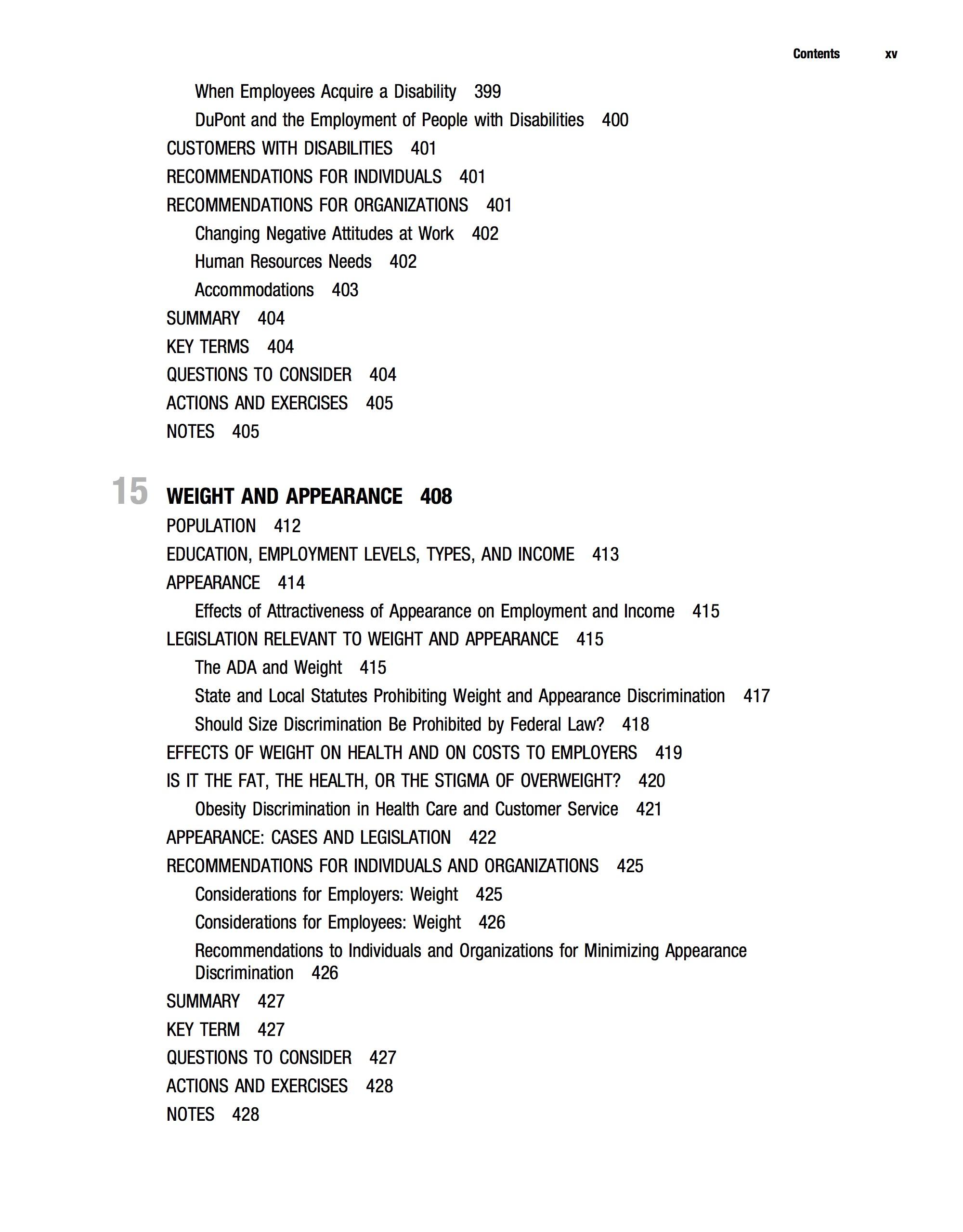
When Employees Acquire a Disability 399
DuPont and the Employment of People with Disabilities 400
CUSTOMERS WITH DISABILITIES 401
RECOMMENDATIONS FOR INDIVIDUALS 401
RECOMMENDATIONS FOR ORGANIZATIONS 401
Changing Negative Attitudes at Work 402
Human Resources Needs 402
Accommodations 403
SUMMARY 404
KEY TERMS 404
QUESTIONS TO CONSIDER 404
ACTIONS AND EXERCISES 405
NOTES 405
WEIGHT AND APPEARANCE 408
POPULATION 412
EDUCATION, EMPLOYMENT LEVELS, TYPES, AND INCOME 413
APPEARANCE 414
Effects of Attractiveness of Appearance on Employment and Income 415
LEGISLATION RELEVANT TO WEIGHT AND APPEARANCE 415
The ADA and Weight 415
State and Local Statutes Prohibiting Weight and Appearance Discrimination 417
Should Size Discrimination Be Prohibited by Federal Law? 418
EFFECTS OF WEIGHT ON HEALTH AND ON COSTS TO EMPLOYERS 419
IS IT THE FAT, THE HEALTH, OR THE STIGMA OF OVERWEIGHT? 420
Obesity Discrimination in Health Care and Customer Service 421
APPEARANCE: CASES AND LEGISLATION 422
RECOMMENDATIONS FOR INDIVIDUALS AND ORGANIZATIONS 425
Considerations for Employers: Weight 425
Considerations for Employees: Weight 426
Recommendations to Individuals and Organizations for Minimizing Appearance
Discrimination 426
SUMMARY 427
KEY TERM 427
QUESTIONS TO CONSIDER 427
ACTIONS AND EXERCISES 428
NOTES 428
16

GLOBAL DIVERSITY 434
DISCRIMINATION AND DIFFERENTIAL TREATMENT AS WORLDWIDE PHENOMENA 437
SEX AND GENDER: THE STATUS OF WOMEN AROUND THE WORLD 439
Population and Participation Rates 439
Sexual Harassment, Segregation, Discrimination , and Other Inequities 439
Wage Inequity and the Glass Ceiling 440
Focus: "Think Manager, Think Male " Worldwide? 440
PEOPLE WITH DISABILITIES 442
Population and Participation 443
Legislation 443
Focus: Disabled People's Experiences in the Workplace in England 443
SEXUAL ORIENTATION 443
Legislation Prohibiting Sexual Orientation Discrimination 444
Focus: Anti-Gay Sentiment among Youth in Belgium and canada 444
POVERTY 444
FACING THE FUTURE: THE BROAD REACH OF DIVERSITY IN ORGANIZATIONS 446
RECOMMENDATIONS FOR CHANGE AT A SOCIETAL LEVEL 447
RECOMMENDATIONS FOR CHANGE AT AN ORGANIZATIONAL LEVEL 447
Management Commitment to Diversity in Organizations 448
Changes in Human Resources Practices 448
Other Employment Considerations 452
Diversity for Service Providers 452
The Role of the Media 453
RECOMMENDATIONS FOR CHANGE AT AN INDIVIDUAL LEVEL 454
SUMMARY 455
KEY TERM 455
QUESTIONS TO CONSIDER 455
ACTIONS AND EXERCISES 455
NOTES 456
Index 459
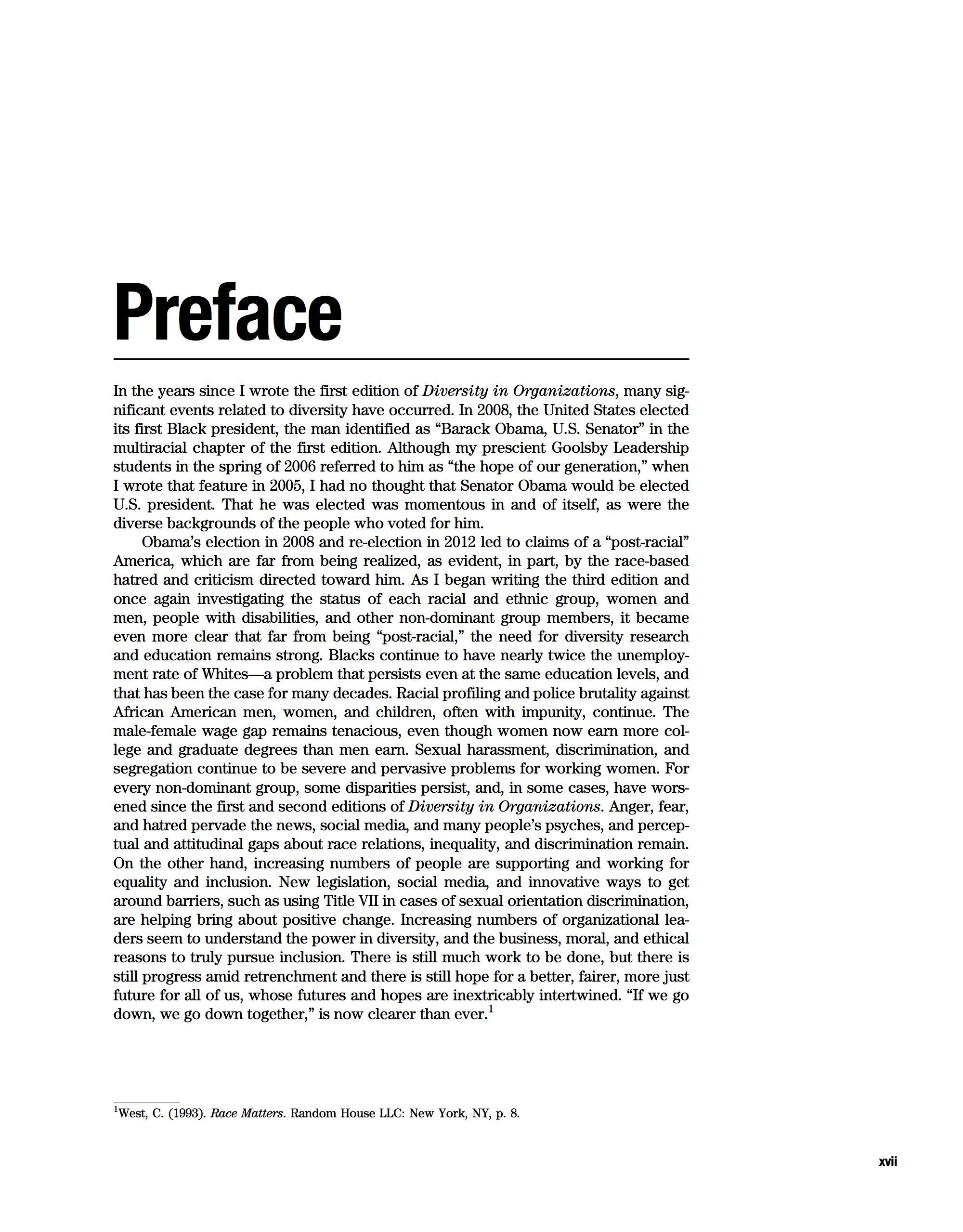
In the years since I wrote the first edition of Diversity in Organizations, many significant events related to diversity have occurred. In 2008, the United States elected its first Black president, the man identified as "Barack Obama, U.S. Senator" in the multiracial chapter of the first edition. Although my prescient Goolsby Leadership students in the spring of 2006 referred to him as "the hope of our generation," when I wrote that feature in 2005, I had no thought that Senator Obama would be elected U.S. president. That he was elected was momentous in and of itself, as were the diverse backgrounds of the people who voted for him.
Obama's election in 2008 and re-election in 2012 led to claims of a "post-racial" America, which are far from being realized, as evident, in part, by the race-based hatred and criticism directed toward him. As I began writing the third edition and once again investigating the status of each racial and ethnic group, women and men, people with disabilities, and other non-dominant group members, it became even more clear that far from being "post-racial," the need for diversity research and education remains strong. Blacks continue to have nearly twice the unemployment rate of Whites a problem that persists even at the same education levels, and that has been the case for many decades. Racial profiling and police brutality against African American men, women, and children, often with impunity, continue. The male-female wage gap remains tenacious, even though women now earn more college and graduate degrees than men earn. Sexual harassment, discrimination, and segregation continue to be severe and pervasive problems for working women. For every non-dominant group, some disparities persist, and, in some cases, have worsened since the first and second editions of Diversity in Organizations. Anger, fear, and hatred pervade the news, social media, and many people's psyches, and perceptual and attitudinal gaps about race relations, inequality, and discrimination remain. On the other hand, increasing numbers of people are supporting and working for equality and inclusion. New legislation, social media, and innovative ways to get around barriers, such as using Title VII in cases of sexual orientation discrimination, are helping bring about positive change. Increasing numbers of organizational leaders seem to understand the power in diversity, and the business, moral, and ethical reasons to truly pursue inclusion. There is still much work to be done, but there is still progress amid retrenchment and there is still hope for a better, fairer, more just future for all of us, whose futures and hopes are inextricably intertwined. "If we go down, we go down together," is now clearer than ever. 1 1
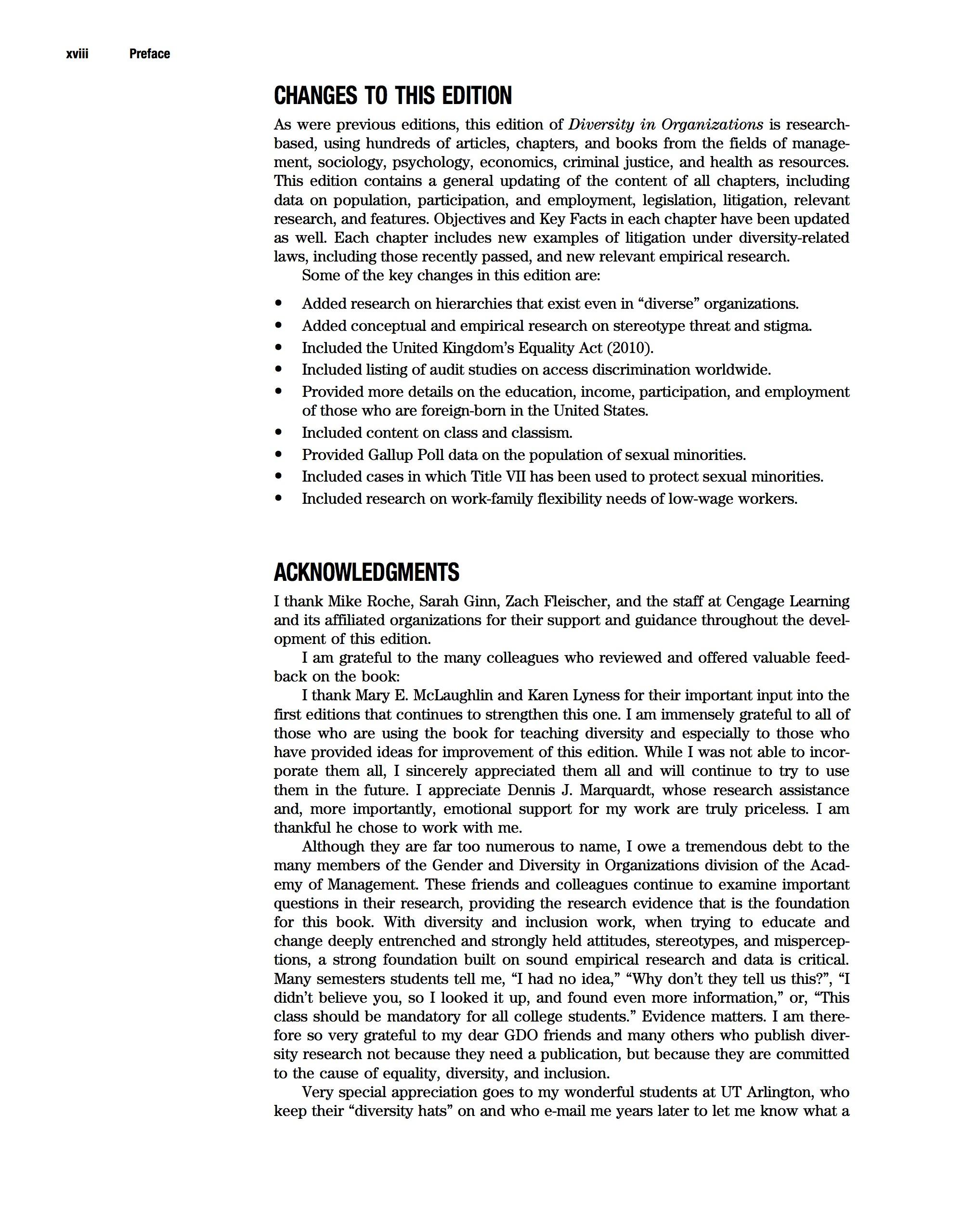
CHANGES TO THIS EDITION
As were previous editions, this edition of Diversity in Organizations is researchbased, using hundreds of articles, chapters, and books from the fields of management, sociology, psychology, economics, criminal justice, and health as resources. This edition contains a general updating of the content of all chapters, including data on population, participation, and employment, legislation, litigation, relevant research, and features. Objectives and Key Facts in each chapter have been updated as well. Each chapter includes new examples of litigation under diversity-related laws, including those recently passed, and new relevant empirical research.
Some of the key changes in this edition are:
• Added research on hierarchies that exist even in "diverse" organizations.
• Added conceptual and empirical research on stereotype threat and stigma.
• Included the United Kingdom's Equality Act (2010).
• Included listing of audit studies on access discrimination worldwide.
• Provided more details on the education, income, participation, and employment of those who are foreign-born in the United States.
• Included content on class and classism.
• Provided Gallup Poll data on the population of sexual minorities.
• Included cases in which Title VII has been used to protect sexual minorities.
• Included research on work-family flexibility needs of low-wage workers.
ACKNOWLEDGMENTS
I thank Mike Roche, Sarah Ginn, Zach Fleischer, and the staff at Cengage Learning and its affiliated organizations for their support and guidance throughout the development of this edition.
I am grateful to the many colleagues who reviewed and offered valuable feedback on the book:
I thank Mary E. McLaughlin and Karen Lyness for their important input into the first editions that continues to strengthen this one. I am immensely grateful to all of those who are using the book for teaching diversity and especially to those who have provided ideas for improvement of this edition. While I was not able to incorporate them all, I sincerely appreciated them all and will continue to try to use them in the future. I appreciate Dennis J. Marquardt, whose research assistance and, more importantly, emotional support for my work are truly priceless. I am thankful he chose to work with me.
Although they are far too numerous to name, I owe a tremendous debt to the many members of the Gender and Diversity in Organizations division of the Academy of Management. These friends and colleagues continue to examine important questions in their research, providing the research evidence that is the foundation for this book. With diversity and inclusion work, when trying to educate and change deeply entrenched and strongly held attitudes, stereotypes, and misperceptions, a strong foundation built on sound empirical research and data is critical. Many semesters students tell me, "I had no idea," "Why don't they tell us this?", "I didn't believe you, so I looked it up, and found even more information," or, "This class should be mandatory for all college students." Evidence matters. I am therefore so very grateful to my dear GDO friends and many others who publish diversity research not because they need a publication, but because they are committed to the cause of equality, diversity, and inclusion.
Very special appreciation goes to my wonderful students at UT Arlington, who keep their "diversity hats" on and who e-mail me years later to let me know what a
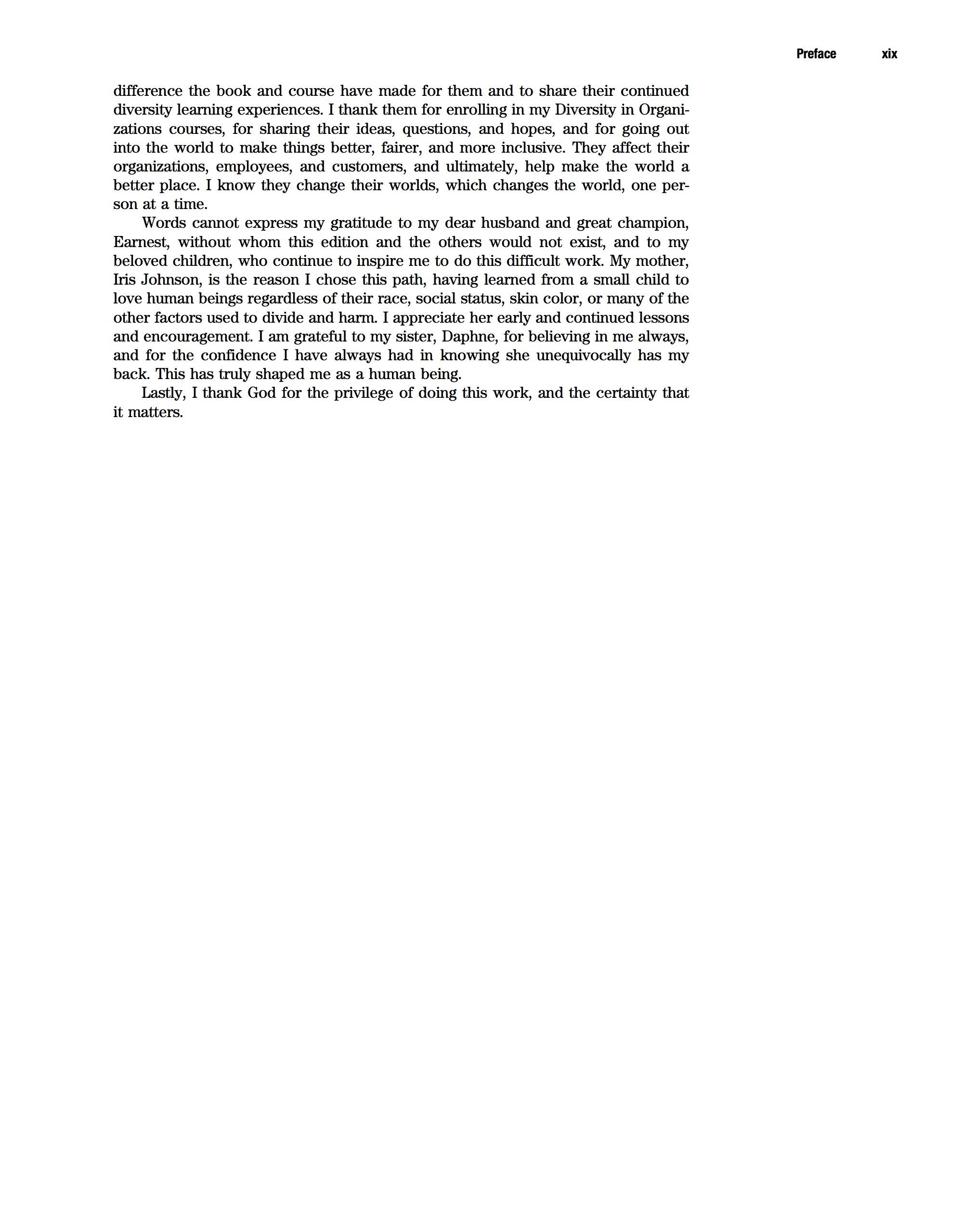
difference the book and course have made for them and to share their continued diversity learning experiences. I thank them for enrolling in my Diversity in Organizations courses, for sharing their ideas, questions, and hopes, and for going out into the world to make things better, fairer, and more inclusive. They affect their organizations, employees, and customers, and ultimately, help make the world a better place. I know they change their worlds, which changes the world, one person at a time.
Words cannot express my gratitude to my dear husband and great champion, Earnest, without whom this edition and the others would not exist, and to my beloved children, who continue to inspire me to do this difficult work. My mother, Iris Johnson, is the reason I chose this path, having learned from a small child to love human beings regardless of their race, social status, skin color, or many of the other factors used to divide and harm. I appreciate her early and continued lessons and encouragement. I am grateful to my sister, Daphne, for believing in me always, and for the confidence I have always had in knowing she unequivocally has my back. This has truly shaped me as a human being.
Lastly, I thank God for the privilege of doing this work, and the certainty that it matters.
After completing this chapter, readers should have a firm understanding of the importance of diversity in organizations. Specifically, they should be able to:
• explain what "diversity" encompasses in the United States and some of the considerations used in determining the relevant diversity concerns in other areas.
• discuss changing population demographics and associated effects on workforce and customer diversity.
• explain interrelationships among diversity, discrimination, and inclusion.
• discuss research on the individual and organizational benefits of diversity and inclusion.

Changing population demographics and changing attitudes toward diversity have considerably increased diversity in many organizations, yet discrimination, inequality, and exclusion persist. Many organizations are more diverse than in the past, yet sexual harassment and segregation, glass ceilings and walls, and social hierarchies remain. 1
Organizational context is important in determining diversity's effect on performance. Properly managed, diversity and inclusion can benefit organizations in the areas of cost, resource acquisition, marketing, creativity, problem solving, and system flexibility.
If an organization develops a reputation for valuing all types of employees and customers, it will become known as an organization in which workers and customers from all backgrounds feel they will be treated fairly.
Working in and learning in environments with people who are different can benefit individuals through intellectual engagement, perspective taking, and greater understanding of the implications and benefits of diversity.

What Is Diversity?
In this book, diversity is defined as real or perceived differences among people in such areas as race, ethnicity, sex, age , physical and mental ability, sexual orientation, religion , work and family status, weight and appearance, social class, and other identity-based attributes that affect their interactions and relationships. 2 These focal areas encompass differences that are based on power or dominance relations among groups, particularly "identity groups," which are the collectivities people use to categorize themselves and others. 3 Identity groups are often readily apparent to others , sources of strong personal meaning , and related to historical disparities among groups in treatment, opportunities, and outcomes.
The definition of diversity includes the terms real and perceived to acknowledge the social constructions of many areas of difference. In particular, although race is socially constructed, perceptions of race , beliefs about people of different races, and discrimination on the bas is of race strongly affect people's life chances and experiences. 4 Similarly, gender is also socially constructed, representing perceptions of how males and females should behave, rather than being representative of biological differences between the sexes that might cause males and females to behave differently. As do perceived racial differences , beliefs about the differences between males and females strongly affect the expectations of, experiences of, and opportunities for girls , boys , men , and women in families, society , and organizations.
In contrast to the categories of focus in this book , some research has explored diversity in terms of functional area (e.g., marketing , finance , or accounting) , tenure, values , attitudes , and social class as they affect people's organizational experiences. These categories may also be sources of real or perceived differences that affect people 's interactions , outcomes, and relationships at work. For example, engineering , finance , and accounting managers typically earn more and have greater occupational status than human resources managers. (The former positions are also more likely to be held by men than the latter position; sex typing and segregation of jobs, and their negative consequences for women, will be discussed in later chapters.) However, one's functional area at work is not likely to fit the criteria for identity groups that is, readily apparent, or associated with historical disparities in treatment, opportunities , or outcomes in society at large.
Social class, referring to those "who occupy a similar position in the economic system of production, distribution, and consumption of goods and services in industrial societies" 5 meets some of the key criteria for inclusion (e.g., having strong personal meaning and stemming from or co inciding with significant power differences among groups; in some situations , it is also readily apparent) Although the

effects of social class are not separately considered, "practices that exclude , exploit, and limit the potential of poor and working-c lass people disproportionately affect women and ethnic minorities , "6 who are covered in individual chapters in this book. For some racial and ethnic groups , upward class movement, along with associated benefits, is possible , given the right circumstances. For other groups , however, even education and income do not insulate them from discriminatory practices and exclusion. For example , regardless of their social class, Blacks must often "contend with being stereotyped as poor, ill- educated , criminal , lazy, and immoral." 7 Along with racial , ethnic, and class relationships, classbased differences related to diversity in organizations are included in many other chapters (e.g., work and family concerns for low wage workers, and part-time work as under-employment, which are more likely for women and minorities) as well. These and other class-based concerns, and their intersections with other diversity issues , are considered in various chapters.
Employment discrimination or labor market discrimination occurs when personal characteristics of applicants and workers that are unrelated to productivity are valued in the labor market. 8 Access discrimination occurs when people are denied employment opportunities , or "access" to jobs, because of their group memberships. Treatment discrimination occurs when people are employed but are treated unfairly on the job, receiving fewer rewards, resources , or opportunities than they should receive based on job-related criteria. 9 In cases of access or treatment discrimination, people with identical productive characteristics, such as performance , education, skills , and tenure, are treated differently because of factors such as race , ethnic origin, sex, age, physical ability, religion , and immigrant status.
Discrimination limits diversity and harms both targeted individuals , vicarious victims, and the organizations that completely miss or limit their contributions, resulting in lower commitment, morale, job satisfaction, and performance among those targeted and sometimes among those who observe it but are not themselves targeted 1 0 It can be intentional and deliberate, or the unintentional result of organizational practices, such as having informal, unmonitored recruiting, selection, or performance evaluation practices. Discrimination may be interpersonal, occurring between individuals, or institutional, related to differential access to goods , services, and opportunities, and not necessarily involving any specific interpersonal encounter. 11 Regardless of intent or source, the outcome of discrimination is that members of some groups are systematically disadvantaged while others are advantaged. These systematic disadvantages include such things as chronically lower wages (e .g., the wage gap for women), chronically higher unemployment (e.g., for Blacks and people with disabilities) , and a host of other negative individual, organizational, and societal consequences. Relationships among diversity , discrimination, individuals, organizations, and society will be discussed throughout the book. 12
Along with efforts to avoid discrimination and ensure that employees are diverse, efforts to ensure employees are also included and able to fully contribute are critical to organizational success. 13 Inclusion is the degree to which "different voices of a diverse workforce are respected and heard. " 14 As we will discuss, organizations can be quite "diverse" on the surface without being at all inclusive. In inclusive organizational cultures, all employees feel as though they are accepted, belong , and are able to contribute to decision-making processes. 15 Thus, throughout the book, "valuing diversity" refers to diversity and inclusion.
MULTIPLE GROUP MEMBERSHIPS AND PERMEABILITY OF BOUNDARIES
People's group memberships affect their outcomes, opportunities, and experiences in society and in organizations. 16 Employment, compensation, advancement, retention, participation, and competitiveness are a few of the outcomes that are related to demographic background. In the United States, those who are White , male , and do not have a disability generally earn higher wages and have higher organizational
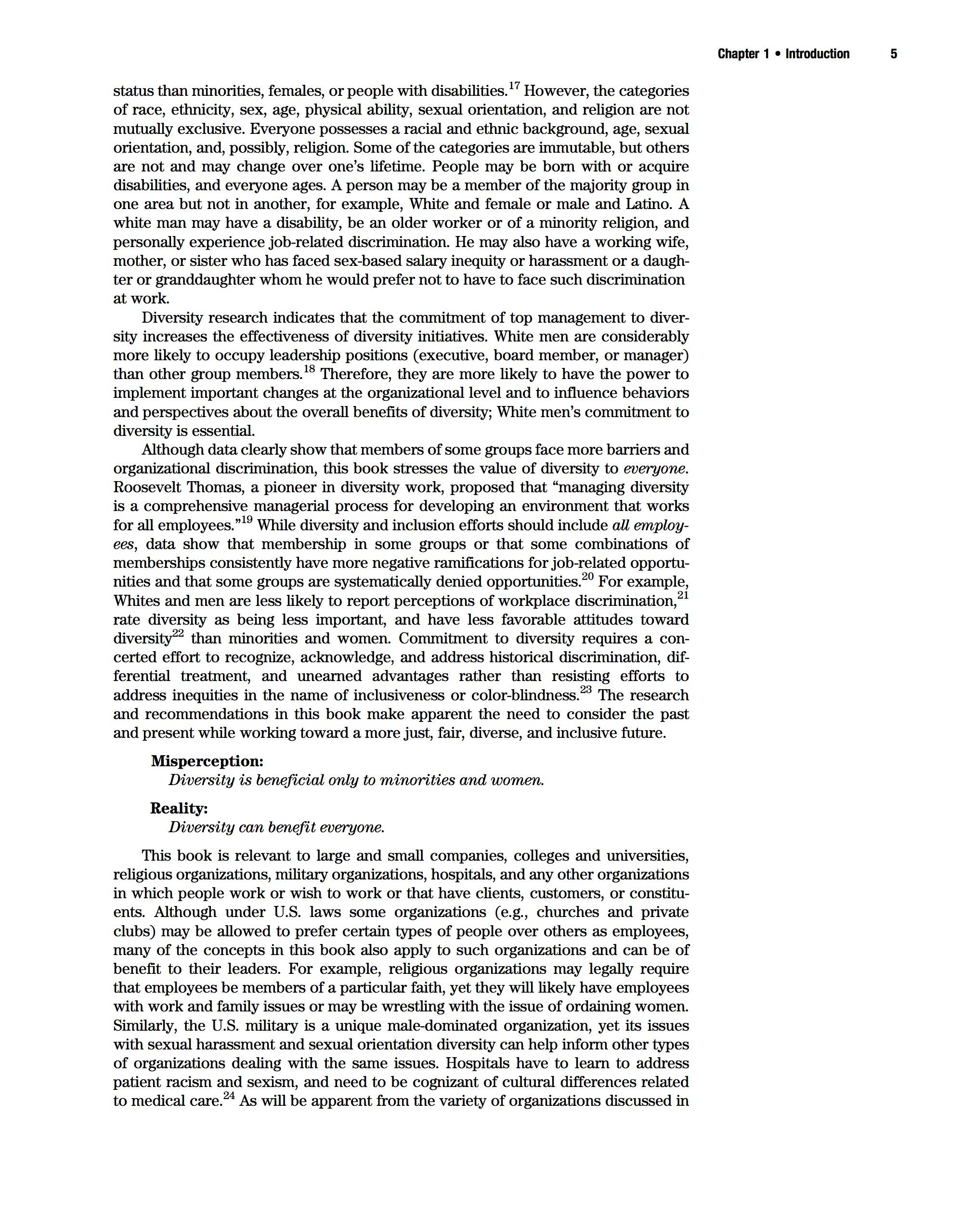
status than minorities, females, or people with disabilities. 17 However, the categories of race, ethnicity, sex, age, physical ability, sexual orientation, and religion are not mutually exclusive. Everyone possesses a racial and ethnic background, age, sexual orientation, and, possibly, religion. Some of the categories are immutable, but others are not and may change over one's lifetime. People may be born with or acquire disabilities, and everyone ages. A person may be a member of the majority group in one area but not in another, for example, White and female or male and Latino. A white man may have a disability, be an older worker or of a minority religion, and personally experience job-related discrimination. He may also have a working wife, mother, or sister who has faced sex-based salary inequity or harassment or a daughter or granddaughter whom he would prefer not to have to face such discrimination at work.
Diversity research indicates that the commitment of top management to diversity increases the effectiveness of diversity initiatives. White men are considerably more likely to occupy leadership positions ( executive, board member, or manager) than other group members. 18 Therefore, they are more likely to have the power to implement important changes at the organizational level and to influence behaviors and perspectives about the overall benefits of diversity; White men's commitment to diversity is essential.
Although data. clearly show that members of some groups face more barriers and organizational discrimination, this book stresses the value of diversity to everyone. Roosevelt Thomas, a pioneer in diversity work, proposed that "managing diversity is a comprehensive managerial process for developing an environment that works for all employees. "19 While diversity and inclusion efforts should include all employees, data. show that membership in some groups or that some combinations of memberships consistently have more negative ramifications for job-related opportunities and that some groups are systematically denied opportunities. 2°For example, Whites and men are less likely to report perceptions of workplace discrimination, 21 rate diversity as being less important, and have less favorable attitudes toward diversity2 2 than minorities and women. Commitment to diversity requires a concerted effort to recognize, acknowledge, and address historical discrimination, differential treatment, and unearned advantages rather than resisting efforts to address inequities in the name of inclusiveness or color-blindness. 23 The research and recommendations in this book make apparent the need to consider the past and present while working toward a more just, fair, diverse, and inclusive future.
Misperception:
Diversity is beneficial only to minorities and women.
Reality:
Diversity can benefit everyone.
This book is relevant to large and small companies, colleges and universities, religious organizations, military organizations, hospitals, and any other organizations in which people work or wish to work or that have clients, customers, or constituents. Although under U.S. laws some organizations (e.g., churches and private clubs) may be allowed to prefer certain types of people over others as employees, many of the concepts in this book also apply to such organizations and can be of benefit to their leaders. For example, religious organizations may legally require that employees be members of a particular faith, yet they will likely have employees with work and family issues or may be wrestling with the issue of ordaining women. Similarly, the U.S. military is a unique male-dominated organization, yet its issues with sexual harassment and sexual orientation diversity can help inform other types of organizations dealing with the same issues. Hospitals have to learn to address patient racism and sexism, and need to be cognizant of cultural differences related to medical care. 24 As will be apparent from the variety of organizations discussed in

this book, diversity issues affect all organizations at some point. In addition, although most of the diversity research that is reported in this book was conducted in the United States, many of the concepts and findings, such as differential treatment based on racial or ethnic heritage, religion, sex, or sexual orientation, are relevant to non-dominant groups in other areas. Chapter 16 discusses these similarities in more detail.
TERMINOLOGY
In this book, when referring to the U.S. population, the following expressions are used somewhat interchangeably: sex/gender, Blacks/African Americans, Latinos/Hispanics, Asians/Asian Americans/Asians and Pacific Islanders, Native Americans/American Indians, Whites/Anglos/European Americans/Caucasians, and minorities/people of color. 25 Although the linked terms are not exactly the same (e.g., sex is biological while gender is socially constructed, 26 and not all Blacks consider themselves African American), the terms are widely recognized, their meanings are generally well understood, and they are often used interchangeably. Even so, there are important differences among them. Indeed, some scholars have argued persuasively that the ambiguity and :fluidity of terminology render "race" and "ethnicity" almost meaningless. 27 Some researchers go so far as to use quotation marks at any mention of the word race to indicate its lack of meaning, despite its real consequences in people's lives.
Like gender, "race is socially constructed to denote boundaries between the powerful and less powerful" and is often defined by the more powerful group. 28 In the United States, these social constructions are reflected by the changes in terminology used by the Census Bureau over the years and in court rulings about who was or was not White. Latinos may be of any race, and people may be of more than one racial or ethnic background, which adds to the complexity of understanding race and what it means. In recent years, increasing numbers of Whites are self-identifying as Latino compared to in prior data collections, 29 further suggestive of the social construction of race. There are also substantial differences in the diversity-related experiences of Latinos who are Colombian, Dominican, Mexican, Nicaraguan, and Puerto Rican, with skin color within country of origin also playing a role. 30
Ethnicity refers to a shared national origin or a shared cultural heritage. Thus, "Hispanic" is an ethnic description, although it is often treated as a racial one. 31 "Asian" is another ambiguous term. Is it an ethnicity, since ethnicity refers to a shared national origin, or is it a race, as the term is often used and understood? As with differences among Latinos, there are considerable differences among Asians who are from Korea and those from India or Vietnam, and among Black Americans, South African Blacks, and those from the West Indies. These and other contextual complexities related to race, ethnicity, sex, and gender and their effects on individuals in organizations will be explored in later chapters.
As discussed further in Chapter 2, instead of the terms majority and minority, which reflect population size, the terms dominant and non-dominant are used at times to distinguish between more powerful and less powerful groups, acknowledging the importance of power in access to and the control of resources. The powerful control more resources and are "dominant," regardless of whether they are more numerous (such as Whites in South Africa and men in the United States). Dominant groups make, interpret, and enforce regulations that affect and control the life chances and opportunities of those who are non-dominant. For example, the U.S. criminal justice system, police forces, the U.S. Supreme Court, Congress, Senate, and the office of the President, who make, interpret, and enforce laws, currently are and have historically been dominated by White men, which is similar to political and legal systems in many other parts of the world. Although many of the distinctions and terminology discussed are U.S.-centric, the idea of dominant and non-dominant groups is not







